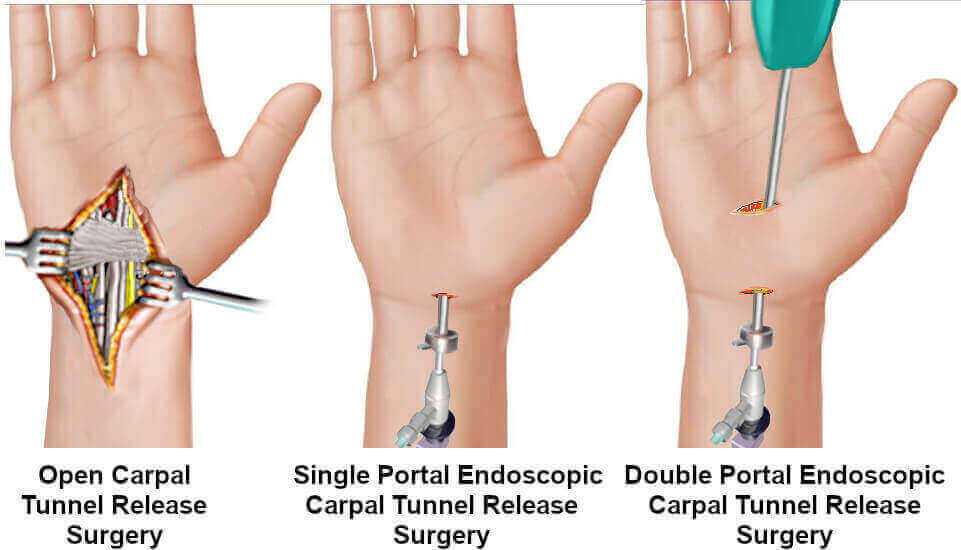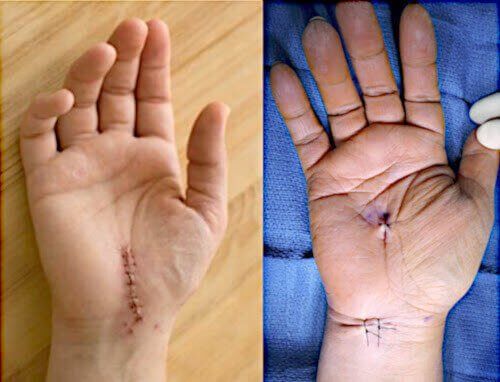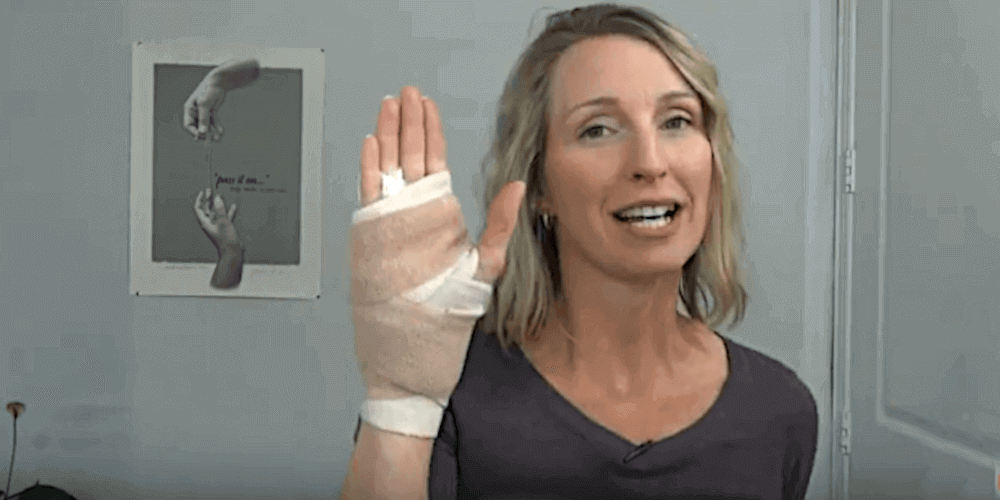Guide to Carpal Tunnel Surgery
From Dr. Z - Carpal tunnel syndrome specialist
A Guide to Carpal Tunnel Surgery
Thinking of having carpal tunnel surgery? No doubt, the pain or numbness in your fingers and hand are driving you mad. You can't work, sleep or do anything normal with your hands anymore. Something needs to be done!
Surgery is certainly one option you can explore. If you saw a doctor already, he or she probably advised you to use non-surgical (non-operative) treatments first. Also called conservative treatments, most work quite well to relieve symptoms.
But perhaps you tried every remedy you can find, but each one failed to work. Now surgery seems like the last option. Hopefully your symptoms are not too far advanced. As any hand surgeon will warn you, the more severe the condition, the less the likelihood of seeing good outcomes from surgery.
But let's stay positive and assume you're a good candidate for carpal tunnel surgery. A good candidate is someone who:
- Is under 70 years old
- Is not pregnant
- Has had severe symptoms for more than 6 months
- Has tried all non-surgical remedies with no success
- Is not obese or a smoker
- Does not have another severe illness or infection
- FIND OUT: do you have carpal tunnel? No strings attached self-test.
When you meet with the hand doctor, he or she will probably recommend carpal tunnel surgery. Their staff will give you a surgery date that works for you. They will also provide a list of things you must do in preparation for surgery.
Be sure to follow those instructions. Read below to see what they generally involve.
Preparing for carpal tunnel surgery
Before carpal tunnel surgery
Stop smoking
While it's not a "requirement" of having surgery, you and your doctor should address smoking. That's because smoking can have a detrimental effect on how well (and fast) you recover from any surgery.
Smoking tobacco constricts blood vessels. It also contributes to forming a larger and more sensitive scar after surgery. In fact, your carpal tunnel symptoms are worsened if you already smoke.
Doctors usually advise you quit smoking 2-3 weeks before surgery. And maintain that 2-3 week cessation after your operation. This will help insure the surgery proceeds well and recovery is optimal.
Discontinue some medicines
Make sure your doctor knows all of the medications you take on a regular basis. Between 3 and 14 days before the surgery, you must stop taking some medications. Your doctor will advise which to stop, and when.
Such medicines usually are those which inhibit healing and also promote bleeding. Examples are:
- Blood thinners like Coumadin and Plavix (stop 3-4 days before surgery)
- Nonsteroidal anti-inflammatory drugs (NSAIDs) like aspirin, Advil, Motrin, Aleve, Celebrex
Limit food and drink
You must not drink or eat anything after midnight before the surgery. You may have a little water in order to take appropriate morning medications.
The reason? Most of the body's reflexes are temporarily shut down with anesthesia. So if your stomach contains residual food or liquid, you risk vomiting into your throat.
Day of carpal tunnel surgery
When you arrive at the surgical site, you will change into a hospital gown. That means before leaving home, don't wear anything fancy or difficult to remove. Rather, loose fitting clothes are best. And leave any valuables like jewelry (earrings, necklaces, rings), and watches at home.
Just before being wheeled into the operating room, you will remove eyeglasses, contact lenses, dentures, piercings and hearing aids. Just before the operation begins, you will probably be given an injection or pill to ease any anxiety.
After the surgery, you will still be under the influence of the anesthesia for up to 48 hours. That means you cannot drive. Therefore, you will be discharged to the care of someone else. So arrange for a ride home in advance.
What are types of carpal tunnel surgery?
There are 2 basic types of carpal tunnel surgery: open and endoscopic. Endoscopic surgery also can be of two basic types, single or double portal. Your doctor will decide on which operation you will have. That's because he or she is skilled in one or the other technique.
Each technique has it's own advantages and disadvantages (pros & cons). These are discussed in more detail below. Generally speaking the following side-by-side comparison outlines the major differences between the two operative techniques.
Open Carpel Tunnel Surgery
- 50% fewer cases of damage to nerve, arteries or tendons
- 90% fewer cases of temporary nerve damage
- Larger, more sensitive & more painful scar
- Approx. 60% less expensive
Endoscopic Carpel Tunnel Surgery (single & double portal)
- 60% fewer cases of complications like excessive pain
- Faster overall recovery
- Faster return to work
- Smaller, less sensitive & less painful scar
Recovering from carpal tunnel surgery
In the recovery room
When the surgery is finished you're brought into a recovery room for about an hour. If you had general anesthesia, you will awaken to see a number of other patients recovering from the same or other operations.
You will not feel much pain in your hand at this point. That's because the doctor injected your hand with a numbing agent.
The staff will constantly make sure you're comfortable. They will inspect the surgical site for bleeding. They will also monitor you for excessive pain or anything else unusual. The staff will also ask you to wiggle your fingers to make sure you have good function.
Here are typical, normal feelings you might have immediately after carpal tunnel surgery:
- Some nausea due to the anesthesia is normal. In that case, the staff will give you a medicine to reduce the feeling.
- If there is any pain in your hand, you will be given a bit more pain medication.
- You might feel cold and shaky. Usually a warm blanket will ease that feeling.
Recovering at home
When you leave the hospital or surgical center, you'll be given a detailed list of instructions to follow at home. They are designed to help lessen the pain and insure you heal as quickly as possible. In fact, the greatest amount of surgery aftercare is devoted to minimizing pain.
The first few days at home are the most difficult. After the anesthetic wears off, the pain in your hand will be intense. But the doctor will have prescribed oral pain medicines to control the discomfort. Be sure to follow the directions for taking that medicine.
Avoid moving around too much in the first 3 days. Doing so only increases the pain. Also be sure to sleep with your hand elevated to minimize pain. Using an extra pillow to rest your hand on will help.
Also avoid bumping your hand. Doing so can bruise the wound site - or worse - rip out the stitches. Either incident will slow your healing significantly.
Finally never wet the bandages. When bathing, hang your hand out of the tub. When showering, wrap your hand tightly in plastic to keep water from seeping in. Wet bandages will encourage infection and prolong healing. This is why doctors discourage bathing or showering altogether until your stitches are removed (in about 10 days).
After about 10 days, you will return to the doctor to remove the stitches. It's a simple and painless process. Then you will be given a wrist splint to wear in order to protect the wound site. The splint also prevents excessive and painful hand movement.
The doctor will prescribe regular hand and finger exercises to do in the next few weeks. They help limber up your fingers and improve strength. Some patients may require physical therapy or hand rehabilitation. That depends on your particular case and the extent of functional loss you experience after surgery.
Returning to work varies according to your pain level and functional status. Most people can return to work in about 2 to 4 weeks after endoscopic or open carpal tunnel surgery, respectively.
Factors affecting recovery time
Your recovery time and the amount of time you must take off work depends on several factors. Your carpal tunnel recovery time will be delayed under the following conditions:
- The operation was performed on your dominant hand.
- If you had open instead of endoscopic carpal tunnel surgery.
- When your occupation requires extensive hand activity.
- You have poor health or a chronic disease (such as diabetes).
- You are smoker.
What's the success rate of carpal tunnel surgery?
Whichever surgical technique is used, about 50-70% of patients are satisfied with their carpal tunnel surgery by 2 years. Another 30-50% of patients are not satisfied with their results by 2 years. Generally, the more severe the symptoms before surgery, the poorer the outcome.
Other consequences of carpal tunnel surgery break down as follows:
- 35% of patients experience some (or significant) symptoms relief within a day. Complete recovery may take months.
- 30% of patients take up to 6 months to experience some (or significant) symptoms relief.
- 35% of patients experience no symptoms relief whatsoever at any time. Nearly 50% of those patients have worse symptoms than prior to surgery.
The surgical scar may feel hypersensitive or tender for up to 12 months. This is especially the case after the open release technique.
It is not unusual for patients to lose some pinch or grip strength, no matter the surgical procedure used. The majority of these patients fully recover their hand strength within a year.
What are the risks of carpal tunnel surgery?
Like any surgical procedure, carpal tunnel surgery has it's own associated risks and complications.
- Overall, pain symptoms return or persist in 41-90% of patients (called "recurrent symptoms").
- About 50% of patients have partial or total loss of feeling for 3 months or more.
- Over 90% of surgical patients still have persistent symptoms after 1 year.
- About 3-10% of patients may have a post-operative infection.
- Between 7-16% of patients have (accidental) surgically induced nerve damage.
- Another 18% of patients may have abnormal pain or stiffness for at least 3 months.
- Up to 40% of patients experience some or permanent loss of hand strength, even with therapy.
- For most patients, work responsibilities (roles) need changing if they don't change jobs.
- One or more carpal tunnel symptoms reappear in about 30% of patients after surgery.
- Over 80% of patients who have carpal tunnel release surgery never return to their original occupation.
- At least 15% of those patients (who had to change careers) switched work roles requiring less use of their hands.
- Sometimes the surgeon advises patients with a failed carpal tunnel surgery to undergo another surgery. The success of such a revision surgery is less than 20%.
Conclusion
There are two basic types of carpal tunnel surgery: open or endoscopic carpal tunnel release. Your doctor will tell you which he or she prefers to use.
The operation you have will have a huge impact on how well and how quickly your hand recovers. Be sure to discuss the pros and cons of each type of surgical technique with your doctor.








